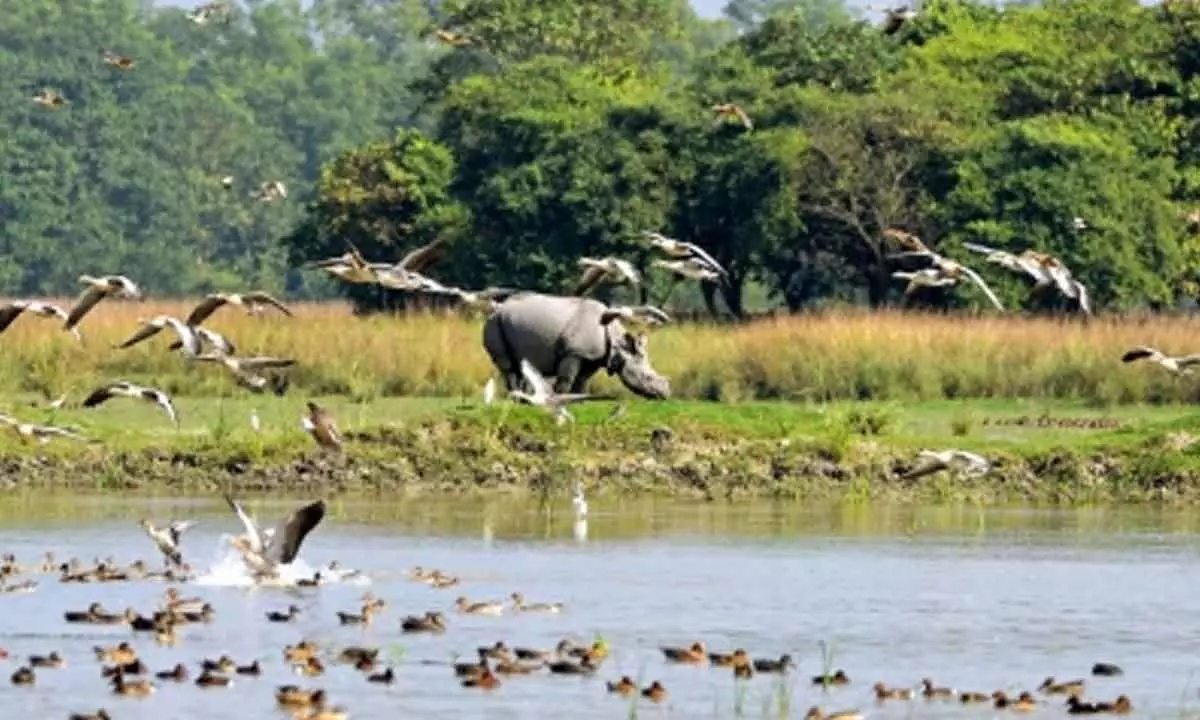Live
- 525 candidates remain in fray for 17 LS seats in Telangana
- Political Prowess on Display: Rajnath Singh and Smriti Irani's nominations galvanise BJP’s poll campaign
- TN government committee identifies 42 elephant corridors in state
- Ola Cabs CEO Hemant Bakshi steps down, firm announces job cuts
- IPL 2024: Kuldeep Yadav's 35 not out propels Delhi to 153/9 against Kolkata
- BJP leader Sambit Patra files nomination for Puri Lok Sabha seat
- Rajiv Pratap Rudy accuses Lalu Prasad of 'killing' developmental schemes in Saran
- Quick action by Telangana Cyber Security Bureau saves citizen's Rs 1 crore
- Types of food diabetics should avoid
- Celebrating National Honesty Day: 20 Quotes to Inspire Integrity
Just In
UN report flags shocking state of wildlife


The landmark report reveals that while some migratory species listed under CMS (Conservation of Migratory Species) are improving, nearly half (44 per cent) are showing population declines. More than one-in-five (22 per cent) of CMS-listed species are threatened with extinction; nearly all (97 per cent) of CMS-listed fish are threatened with extinction. The extinction risk is growing for migratory species globally, including those not listed under CMS; half (51 per cent) of key biodiversity areas identified as important for CMS-listed migratory animals do not have protected status
The first-ever State of the World’s Migratory Species, released by the Convention on the Conservation of Migratory Species of Wild Animals (CMS), a UN biodiversity treaty, at the opening of a major UN wildlife conservation conference (CMS COP14), has revealed some startling facts.
The landmark report reveals that while some migratory species listed under CMS are improving; nearly half (44 per cent) are showing population declines, more than one-in-five (22 per cent) of CMS-listed species are threatened with extinction; nearly all (97 per cent) of CMS-listed fish are threatened with extinction; the extinction risk is growing for migratory species globally, including those not listed under CMS; half (51 per cent) of key biodiversity areas identified as important for CMS-listed migratory animals do not have protected status; and 58 per cent of the monitored sites recognized as being important for CMS-listed species are experiencing unsustainable levels of human-caused pressure.
The two greatest threats to both CMS-listed and all migratory species are overexploitation and habitat loss due to human activity. Three out of four CMS-listed species are impacted by habitat loss, degradation and fragmentation, and seven out of 10 CMS-listed species are impacted by overexploitation, including intentional taking as well as incidental capture.
Climate change, pollution, and invasive species are also having profound impacts on migratory species. Globally, 399 migratory species that are threatened or near threatened with extinction are not currently listed under the CMS.
Until now, no such comprehensive assessment on migratory species has been carried out. The report provides a global overview of the conservation status and population trends of migratory animals, combined with the latest information on their main threats and successful actions to save them.
Inger Andersen, Executive Director of the United Nations Environment Programme, said: “Today’s report clearly shows us that unsustainable human activities are jeopardising the future of migratory species -- creatures who not only act as indicators of environmental change but play an integral role in maintaining the function and resilience of our planet’s complex ecosystems. “The global community has an opportunity to translate this latest science of the pressures facing migratory species into concrete conservation action. Given the precarious situation of many of these animals, we cannot afford to delay, and must work together to make the recommendations a reality.”
Billions of animals make migratory journeys each year on land, in rivers and oceans and in the skies, crossing national boundaries and continents, with some travelling thousands of miles across the globe to feed and breed. Migratory species play an essential role in maintaining the world’s ecosystems, and provide vital benefits, by pollinating plants, transporting key nutrients, preying on pests, and helping to store carbon.
Prepared for CMS by conservation scientists at the UN Environment Programme World Conservation Monitoring Centre (UNEP-WCMC), the CMS State of the World’s Migratory Species report uses the world’s most robust species data sets and features expert contributions from institutions, including BirdLife International, the International Union for Conservation of Nature (IUCN), and the Zoological Society of London (ZSL).
The main focus of the report is the 1,189 animal species that have been recognised by CMS Parties as needing international protection and are listed under CMS, though it also features analysis linked to over 3,000 additional non-CMS migratory species.
Species listed under the Convention are those at risk of extinction across all or much of their range, or in need of coordinated international action to boost their conservation status.
Amy Fraenkel, CMS Executive Secretary, said: “Migratory species rely on a variety of specific habitats at different times in their lifecycles. They regularly travel, sometimes thousands of miles, to reach these places. They face enormous challenges and threats along the way, as well at their destinations where they breed or feed.
“When species cross national borders, their survival depends on the efforts of all countries in which they are found. This landmark report will help underpin much-needed policy actions to ensure that migratory species continue to thrive around the world.”

© 2024 Hyderabad Media House Limited/The Hans India. All rights reserved. Powered by hocalwire.com






